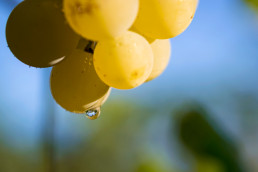“Noble” Grapes Become World’s Most Planted
In 1990, most of the world’s most widely planted grape varietals were either generally unknown, unpronounceable or both. Twenty years later, Cabernet Sauvignon is king, Merlot is queen and Tempranillo, Chardonnay and Syrah are powerful princes. And what of Rkatsiteli, Sultaniye, Mazuelo and Bobal? They’re now somewhere down the food chain with the common folk. In fact, only one of the top three grapes in 1990—Airen, an obscure (in the U.S., at least) Spanish white wine grape—remained among the leading trio in 2010, though falling from first to third behind Cabernet and Merlot.
These are just some of the findings of a recently released database of the world’s wines compiled by professor Kym Anderson of the University of Adelaide. Among the report’s other findings:
· The fastest-growing varietal in the world is Tempranillo, the chief grape of Rioja and increasingly blended with other red wine grapes, which since 1990 has gone from constituting 5 percent of Spain’s vineyards to 20 percent.
· Wine drinkers worldwide are drinking more red wine and growers are planting more red wine grapes. From 2000 to 2010, the global share of red varietals has gone from 49 percent to 55 percent.
· The amount of land given to winegrape production in the U.S. has increased by 30 percent in the 2000-2010 time period, the largest increase in terms of acreage, though New Zealand and Australia have put new land into production at a faster rate.
The report doesn’t hazard a guess as to why any of these development have taken place, though it lists terroir, marketing and the ability of the most popular winegrapes to grow well in a variety of locations as possible explanations.
California Vintners Praying for Rain
California’s on-going drought has yet to materially affect the state’s winegrape growers, but that doesn’t mean they’re not looking to the heavens, praying some of that wet stuff starts falling.
Last year was dubbed the driest year ever in California history, and the heavenly spigot has stayed off so far in 2014, prompting government officials to ask the public for voluntary water cutbacks and Gov. Jerry Brown to issue a drought emergency declaration. As if that weren’t enough, the two previous years were dry as well, though not to the same degree.
The persistent drought is caused by a high-pressure system parked off the coast of the Pacific Northwest, shunting storm systems north to Alaska and Canada, which have seen an unusually wet winter. Though in the near term forecasters don’t see much relief in sight, the longer term outlook may contain a ray of hope. Some computer models are predicting the return of an El Nino weather pattern, which tends to send storms hurtling towards California, perhaps as early as March.
And if the state’s vintners can squeak by the current drought conditions, there is the tiniest glint of a silver lining. Later and less irrigation results in stressed out grapevines, which in turn produce more intensely flavorful grapes. It may be small consolation, but consolation nonetheless.
2013 California Harvest Offers Both Quality and Quantity
Following on the heels of a highly regarded 2012 wine grape crop that brought smiles to the faces of California growers and winemakers, the 2013 harvest should keep those smiles firmly in place.
A growing season with stable, not-too-hot, not-too-cool temperatures ending with a heat wave that ripened grapes up to a month earlier than previous harvests had vintners scrambling to pick but is expected to result in wines with plenty of rich, concentrated fruit flavors. When all is said and done (and picked) this year’s harvest is estimated to come in at around 3.7 million tons, a close second to the 4 million tons harvested in 2012.
Growers and winemakers have been tossing around terms like “outstanding,” “exceptional” and “amazing” to describe the quality of grapes, with particular plaudits handed out for Pinot Noir, Merlot and Cabernet Sauvignon. The only fly in an otherwise estimable ointment was that the supply of grapes sometimes outstripped wineries’ capacity to store them, though after relatively small crops in 2010 and 2011, it’s a problem most were happy to have.
It’s a problem many European vintners would likely be happy to have too, as a combination of drought, wind and hailstorms, and cool weather have wreaked havoc with the harvests in France, Austria and Greece, which is expected to result in higher prices for the 2013 vintage and put their wines at a competitive disadvantage vis-à-vis domestic bottles.
Wine Shortage Fears
A recent sky-is-falling report from Morgan Stanley Research suggested a global wine shortage may soon be in the offing. The report says worldwide demand outpaced supply by some 300 million cases in 2012, citing a rise in global wine consumption, particularly in the United States and China, along with a decline in wine production in the world’s three largest producers—France, Italy and Spain.
But other analysts say this doomsday forecast is a mere tempest in a wine goblet. They note that the 2013 harvest in Europe is projected to be substantially greater than in the last several years, and that the year’s harvest in California—the world’s fourth largest wine producer—will also be larger than average, rivaling 2012’s record crop. Chile and New Zealand also reported record wine production.
Further, analysts also note that much of the European decrease in production was deliberate, as vintners pulled back in the face of a glut of wine grapes. In fact, according to the International Organization of Vine and Wine, an intergovernmental winemaking and growing agency, the “significant global harvest” of 2013, which it attributes to “the development in the productivity of vineyards,” should result in a net increase in global wine production this year of almost nine percent.
So while having a basement full of wine may not be a bad thing, you don’t have to run right out and start stocking up.
Wine News Briefs
This year’s outlook for bulk wine supplies of Cabernet Sauvignon and Pinot Noir in Northern California is promising. Despite two successive large harvests, demand for both varietals—especially Pinot Noir—remains strong, Clements said, writing in the North Bay Business Journal. The prognosis for Chardonnay and Sauvignon Blanc isn’t quite so rosy, while the market for Merlot has been and continues to be soft.
· Even with a sluggish economy at home and abroad, many wine industry executives are remain optimistic about the global economy’s affect on their business, according to wine and spirits news site Harpers. Some 75 percent of the executives set to attend the inaugural Wine Vision conference, to be held in London in late November, said they were “confident” or “very confident” both in the near and long terms. One major concern: government regulation and taxes, cited by 40 percent of the executives as the most important issue facing the industry.
· Though delayed by the government shutdown in October, as of Nov. 1 there are four new American Viticultural Areas in California. Approved by the federal Alcohol and Tobacco Tax and Trade Bureau, were AVAs in Ballard Canyon in Santa Barbara, Moon Mountain District in Sonoma, and Big Valley District and Kelsey Bench in Lake County.
Bulk Wine Briefs
· A healthy wine grape harvest in California in 2012, coupled with an expected robust harvest in 2013, have the state’s wineries slowing down their purchase of bulk wine grapes from foreign sources (mostly Chile, Argentina and Australia) and ramping up their deliveries from bulk wine producers in their own backyard, according to recent reports. At mid-year, U.S. bulk wine imports were down by 22 percent, noted the authoritative Gomberg-Fredrikson Report.
· Were the ancient Romans the first producers of bulk wine? Could be, says a winemaker-slash-archeologists examining a pair of structures in Oplontis, a town near Pompeii that was destroyed by the eruption of Mount Vesuvius in 79 AD. According to Dr. Michael Thomas, head of the Oplontis Project that is studying the site, one of the structures first thought to be a wealthy citizen’s villa is more likely an ancient wine co-op, where grapes from surrounding vineyards were pressed into wine, which was then shipped by boat to other, thirstier areas. The Oplontis Project plans release of an ebook documenting its findings, as well as “fully navigable 3D models” to enable others to conduct further studies.
· The weather in Bordeaux is notorious for it fickleness and occasional brutality, evidenced again this summer by hailstorms that damaged almost 62,000 acres of vineyards. To make up for the shortfall of wine grapes, the local governing body has allowed vintners to purchase bulk wine of specified appellations and vintages until July of next year. Bordeaux winemakers have also asked the French government for emergency help, so far to no avail.


